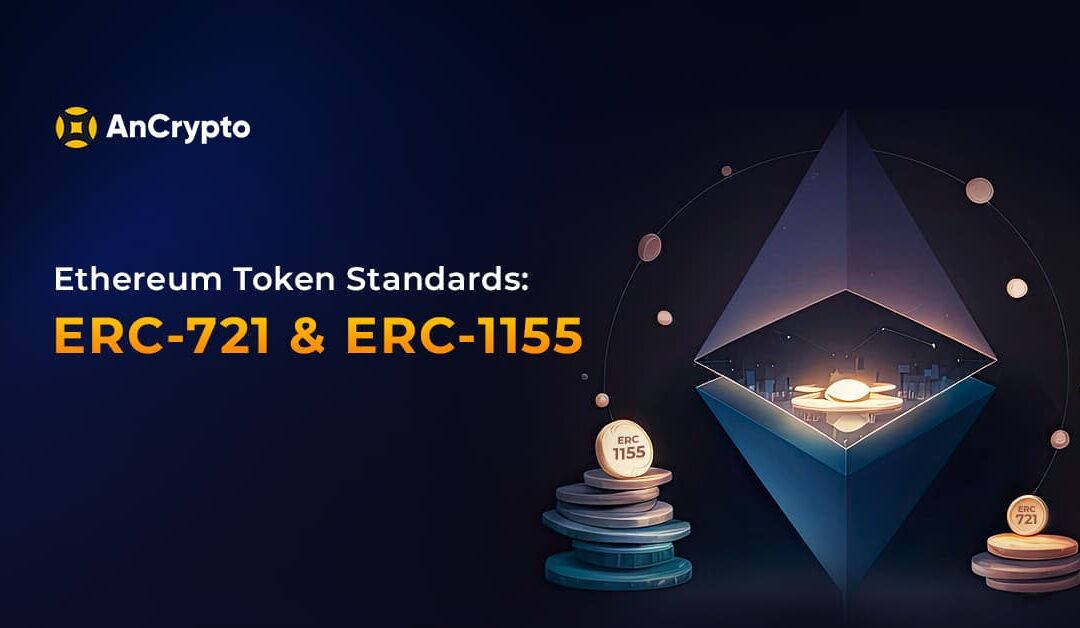
Ethereum Token Standards: ERC-721 & ERC-1155
As NFTs continue to grab the attention of everyone, the debate surrounding two notable Ethereum token standards ERC-1155 & ERC-721 is becoming crucial to address. Both are the Token standards used for NFT transactions in the Best NFT wallets and marketplaces. Before understanding the ERC-721 and ERC-1155, grasp the concepts of tokens, token standards, and ERCs.
Tokens: Tokens are digital assets existing on the blockchain. Governed by smart contracts, tokens can be bought, sold, or traded, representing a wide range of items, from cryptocurrencies and collectibles like NFTs.
Token Standards: Token standards comprise predefined rules representing how tokens are minted (created) and how they function on the blockchain.
Think of Token standards as recipes, ensuring uniformity, just as a Domino’s pizza recipe ensures consistency worldwide.

ERC: A Brief Introduction
ERC stands for ‘Ethereum Request for Comments’. It serves as a blueprint for programmers to create smart contracts on the Ethereum Blockchain which describes the regulations that Ethereum-based tokens must adhere to.
To review these documents, Ethereum follows the procedure known as the ‘Ethereum Improvement Proposal’ (EIP). By using this process, community members provide feedback and suggestions, which may prompt the document’s originator to make revisions.
Once an EIP has successfully navigated the reviews, the Ethereum community formally accepts it, finalizes the details, and developers subsequently implement it. This transformative journey is how an EIP evolves into an ERC. Essentially, ERCs begin their life as EIPs and can cover a range of topics, such as token standards, naming conventions, and more.
While multiple Ethereum standards exist, ERC 721 and ERC 1155 are among the most recognized and widely embraced Ethereum standards.
ERC-721 and ERC-1155: NFT Standards
1. ERC-721: Non-Fungible Tokens
Introduced in 2017 as an upgrade to ERC-20, ERC-721 is a standard to create non-fungible digital tokens on the Ethereum blockchain, serving as proof of ownership.
These tokens are distinguishable, unique, and indivisible, representing a collection of assets having a different value from one another, even if they belong to the same contract.
For example:
Video game characters and animated characters can be represented using ERC-721 tokens.
Functionalities Supported By ERC 721 Tokens
- Represent ownership of distinctive digital assets.
- Allow token transfer between accounts, so users can trade NFTs for other cryptocurrencies.
- Support indivisible tokens with special identification numbers.
- Include asset information in the metadata.
- Allow third-party contracts to control, transfer, and approve requests.
- Retrieve a list of the owned tokens using enumeration.
- Release events for actions involving tokens.
- Implement standard extensions using standard interfaces.
- Support royalty payments made on secondary sales.
- Compatible With NFT Marketplaces.
The ERC-721 standard goes beyond Ethereum Blockchain. Binance Smart Chain and Tron have their variations, known as BEP-20/721 and TRC20/721, respectively, created using ERC as a standard foundation.
2. ERC-1155: Multi-token Standard
Introduced in 2019, ERC-1155 is an amalgamation of ERC-20 and ERC-721 while addressing their flaws and limited functionalities.
While ERC-720 and ERC 721 Tokens are deployed using different contracts, the ERC-1155 enables the creation of fungible, partially fungible, and non-fungible tokens using a single smart contract.
This standard offers a versatile solution, accommodating various token types and improving overall Ethereum functionality.
For example:
If someone needs to buy 5 NFTs, they are required to execute 5 separate transactions ( with ERC-721) costing more in fees and congestion the network. ERC-1155, however, offers efficiency.
Users can execute multiple transactions with a single smart contract Each token I.D. will be unique with its metadata, supply, and attributes.
This user can transfer all 5 tokens in one transaction which is faster and more cost-effective, saving on gas and reducing network congestion.
Functionalities Supported By ERC 1155
- Represent both Fungible and Non-Fungible assets.
- More economical and gas-efficient.
- Enables multi-token transactions in single approval using batch transfers.
- Manage various assets under a single contract for multiple assets.
- Complete deals must be executed, or none at all.
- Include asset information in the metadata.
- Release events for actions involving tokens.
- Utilisable across several platforms and blockchains.
Key Differences: ERC-1155 vs. ERC-721
- Batch Transfers:
- Token Support:
- Transaction Security:
- DEX Support:
- Metadata Flexibility:
ERC-1155 supports batch transfers, reducing network congestion and gas costs by up to 90%, whereas ERC-721 executes individual transactions for each NFT.
ERC-1155 supports the creation of infinite fungible tokens, and non-fungible tokens, providing flexibility for conversions. ERC-721 is exclusive to non-fungible tokens, and each token requires a new smart contract.
ERC-1155 includes transfer security, allowing easy reclaiming of tokens sent to the wrong address, and enhancing asset security.
ERC-1155 has built-in DEX support, while ERC-721 lacks this functionality.
ERC-1155 offers more flexibility in maintaining Uniform Resource Identifier (URI) codes as smart contracts are linked to multiple URIs compared to ERC-721’s static metadata stored directly in the token ID’s smart contract which limits the flexibility & increases operational cost.
ERC-721 or ERC-1155: Which One Is Better For NFTs?
Both ERC-721 and ERC-1155 have their own merits, and which one you would use depends upon your requirements and preferences. Some NFT collectors exclusively acquire ERC-721 NFTs, considering them the best token standards, while others maintain a more open stance, with no specific preferences. On the other hand, ERC-1155 presents a cost-effective and streamlined alternative by mitigating gas fees and offering budget-friendly mint NFTs minting.

AnCrypto: Shaping The Path To The Future Of NFTs
To build your unique NFT portfolio, encompassing both ERC721 and ERC1155 tokens, opt for AnCrypto—a crypto wallet for NFTs designed to meet diverse NFT needs. Our foremost objective is to empower NFT holders with secure management and provide a user-friendly platform for effortless NFT sharing.



